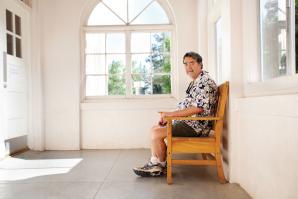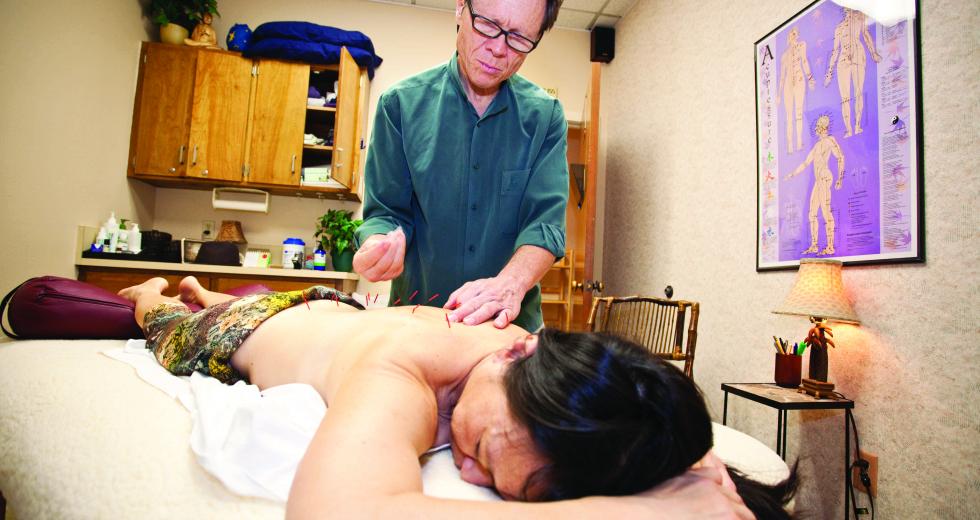With conventional health care becoming more technologically advanced and increasingly expensive, Dr. Maxine Barish-Wreden sees the future of medicine embracing meditation, massage, yoga, tai chi, nutrition and other “softer therapies.”
They aren’t big money-makers, but they help people maintain wellness. “That really is going to be the heart of what we do,” says Barish-Wreden, an internist at Sutter Medical Group in Sacramento who also uses nontraditional medicine in her practice.
Barish-Wreden is the director of Sutter Health’s integrative medicine team in Sacramento, a regional network she launched five years ago to provide access to a wide spectrum of therapies, including medical doctors, a naturopathic doctor, chiropractors and an acupuncturist.
With interest in integrative medicine strong, she plans to expand the network of about two dozen practitioners to nearly 30 this year, change the name to the Sutter Centers for Integrative Holistic Health and unveil an overhauled website this spring.
The program makes Sutter part of a growing national trend. Along with other major health systems in the Capital Region — Mercy, UC Davis and Kaiser Permanente — Sutter is among an increasing number of hospitals nationwide using complementary and alternative medicine in patient care.
Alternative medicine is defined as using medical treatments outside the realm of conventional medicine in place of traditional care, according to the National Center for Complementary and Alternative Medicine, a part of the U.S. National Institutes of Health. An example might be taking St. John’s wort for depression instead of a psychiatrist-prescribed antidepressant. Complementary medicine is used with conventional care, such as using aromatherapy after surgery to minimize discomfort.
While medical professionals often use the terms complementary and integrative medicine interchangeably, NCCAM defines integrative medicine as using the best evidence-based therapies from complementary and alternative medicine along with conventional medicine, such as using acupuncture to lessen nausea after chemotherapy treatment.
Hospital systems around the Capital Region are integrating alternative medicine into their conventional medical practices for inpatient and outpatient care. At Sutter Medical Center, offerings include dance, music, and pet and art therapies. The Sutter Health hospital system also networks regional integrative medicine practitioners based in Sacramento and Davis. Mercy Hospital of Folsom offers a complementary care clinic to the public open most Wednesdays.
At Kaiser, chosen doctors keep up to date on complementary and alternative medicine and give presentations to their colleagues. At UC Davis Health System, doctors who don’t normally work together collaborate on teams that can include alternative care practitioners.
Kaiser added complementary care more than 10 years ago. Alternative medicine is integrated into every patient visit, if appropriate, in an attempt to make a “seamless connection” between alternative and conventional medicine, says Dr. Hillary Campbell, a Kaiser internist and one of the hospital’s complementary and alternative medicine representatives.
Most alternative practitioners in Kaiser’s network are employees. Offerings include acupuncture, guided imagery podcasts to help insomnia and reduce stress, biofeedback and a variety of classes, including meditation, Pilates and tai chi. Kaiser also studies the safety and efficacy of herbal supplements. Herbs don’t need U.S. Food and Drug Administration approval before they’re marketed, which means they can be contaminated with potentially lethal substances or not match their advertised potency. Herbs that Kaiser doctors have deemed safe and effective are mixed and sold in Kaiser pharmacies.
In her role as a complementary health representative for Kaiser, Campbell talks to doctors about what works and what doesn’t. Doctors need to feel comfortable talking to their patients about alternative medicine because patients are practicing it on their own, she says.
“You’re not just sick in the body when you go through illness. There’s a soulfulness and a heart and emotional component to illness, and we want to address all those parts of a person.”
Peggy Gulshen, art therapist, Sutter Cancer Center
She took on the role about a year ago because many of her patients were using Chinese herbs, which she knew nothing about, and it intimidated her. Her patients buy herbs online. Some are immigrants who use their own unconventional health care practices. “You have to be very open to talk about that with them and understand that they might be practicing health care in a different way than we do,” she says.
According to an American Hospital Association survey, a growing number of hospitals are using at least one form of complementary medicine. Those include acupuncture, homeopathy, herbal medicine and massage. In 2008, the most recent survey available, 20.9 percent of respondents offered complementary medicine, up from 8.6 percent in 1998.
Marcia Taylor-Carlile, a registered nurse at Mercy Hospital of Folsom, started the hospital’s complementary care clinic, the Caring Center, in 2001. The center offers only noninvasive treatments aimed at bringing patients into a state of deep relaxation. Taylor-Carlile chooses evidence-based therapies shown to be safe and effective, such as massage, reflexology and acupressure.
Volunteer practitioners staff the center, which is open most Wednesdays from 7 p.m. to 9 p.m. The center does not produce revenue, and treatments are free. Donations cover the cost of materials, such as massage linens and tables. Taylor-Carlile started the center as a way to educate the public about complementary medicine and provide a medical service to people who couldn’t afford to pay for care.
A 2007 government survey showed that 38 percent of adults in the U.S., and about 12 percent of children, are using complementary and alternative medicine. The survey also found that 83 million U.S. adults spent $33.9 billion out-of-pocket on complementary and alternative care, including practitioner visits and complementary and alternative medicine products and classes in the past 12 months. Because most complementary care is paid for out of pocket, it is most accessible to those who can afford it. “For many people, if their health insurance does not provide a way for them to receive these therapies or treatments, they’re not going to get them,” Taylor-Carlile says.
Patients are driving the movement toward using complementary medicine with 84 percent of U.S. hospitals citing patient demand for their main reason in offering these services, according to the 2007 Health Forum survey.
“It’s a consumer movement, and hospitals just saw themselves as being left out of the loop because patients are going and seeking out these services outside of the traditional hospital system,” says Sita Ananth, who conducted the 2007 Health Forum survey and is now director of communications and knowledge services with the Alexandria, Va.-based Samueli Institute. “They are looking for these services and hospitals are looking for ways to respond to the needs of their communities. They believe in it. It’s part of their mission to serve their community.”
There has been steady growth in using complementary and alternative medicine in hospitals nationally on an outpatient basis, but inpatient growth has been sluggish, Ananth says. Offering complementary medicine can be complex. On an inpatient basis, hospitals have to deal with credentials to practitioners and infection control, among other issues.
Another challenge is how to pay for it. Most complementary and alternative hospital programs cost less than $200,000 to start up, a small financial investment, according to the Health Forum survey. Complementary therapies are not typically revenue-producers for hospitals, which can make sustaining and justifying the services difficult. They also may not get reimbursed by insurance. Profit margins are low compared to conventional therapies. Alternative therapies, such as acupuncture, chiropractic and biofeedback, are labor intensive compared to a 10- or 15-minute doctor visit. Because most patients are paying out of pocket, hospitals would need to offer services at competitive rates, Ananth says.
Sutter pays for some of its complementary therapies through philanthropy. The hospital system in Sacramento has a robust outpatient art therapy program for cancer patients and their families, funded through its Sutter Medical Center Foundation, which pays for the therapists’ salaries and supplies. Services are free to patients, regardless of hospital affiliation.
Peggy Gulshen, an art therapist at Sutter Cancer Center, says the art programs are vital to a cancer patient’s care. Art can validate people’s experiences, helping them understand their diagnosis or loss better than words. It can boost energy, inspire a positive outlook and help reduce stress.
“Insurance companies can throw up enormous road blocks.”
Dr. Scott Fishman, chief of the division of pain medicine, UC Davis Health System
The art therapy programs “make Sutter a destination and not just a place you come to because you’re sick,” says Gulshen, who runs the art therapy programs. “You’re not just sick in the body when you go through illness. There’s a soulfulness and a heart and emotional component to illness, and we want to address all those parts of a person.”
At UC Davis Health System, care is collaborative, with doctors of different disciplines who don’t normally work together doing so, says Dr. Scott Fishman, chief of the Division of Pain Medicine and professor of anesthesiology and pain medicine. The collaborative model also means the hospital system is open to integrating alternative medicine into patient care. Fishman works at the hospital’s spine center, which in addition to orthopedic surgeons, pain medicine doctors and other specialists, has clinicians focused on nontraditional healing methods, including tai chi, meditation and hypnosis.
One problem UC Davis and other hospital systems face, Fishman says, is insurance reimbursement. Because alternative care is largely a cash business, while traditional medicine is not, it’s hard to work with insurance companies and have some care not covered, Fishman says. “The patients really struggle with that and insurance companies can throw up enormous road blocks.”
Insurance coverage is complicated. Some insurance companies cover a practitioner’s full rate, while others negotiate a reduced rate or offer patients a discount, practices some health professionals reject. Coverage can vary by plan. Blue Shield of California, for example, includes chiropractic coverage for most PPO plans for outpatient care. Coverage of acupuncture depends on the employer, who must specify it in the health plan, says Julie Lintz, senior network management specialist with Blue Shield of California.
Fishman says a health insurer would rather pay him $1,000 for a 10-minute spinal injection, than $100 for him to spend an hour talking with a dying patient about end-of-life issues and prioritizing care.
“That’s because they understand what the injection is and what the outcome is, but they don’t know how to weigh and balance the more qualitative, interpersonal part of the care, which we all know is critical,” he says. The same is true of alternative medicine, he says, which lacks the body of research compared to traditional medicine.
Conventional and alternative medical providers in the Sacramento region say the best way to provide care is an integrative approach. “Clearly if you look at what is possible from conventional and nonconventional options, the best care is care that integrates the best of both,” Fishman says. “Medicine is starting to realize that.”
Recommended For You

Convenient Care
How concierge medicine is changing the health care marketplace
Think of your best friend, a friend that knows all your ticks, hobbies and vices. Now imagine this friend happens to be a doctor, and she’s your doctor.

Alternative Lifestyle
In holistic medicine, patients find healing and hogwash
On a spring day in 2011, 60-year-old Russell Edgar checked himself into a 14-day Newstart residential program at the Weimar Center. In the Sierra Nevada foothills above Sacramento, the center promised to teach people with diabetes, obesity and cancer how to reverse their health problems through natural healing methods.



